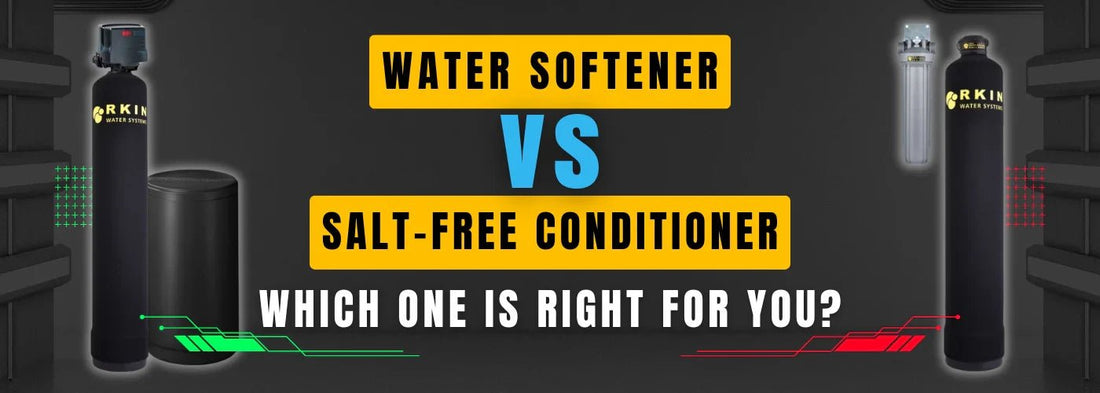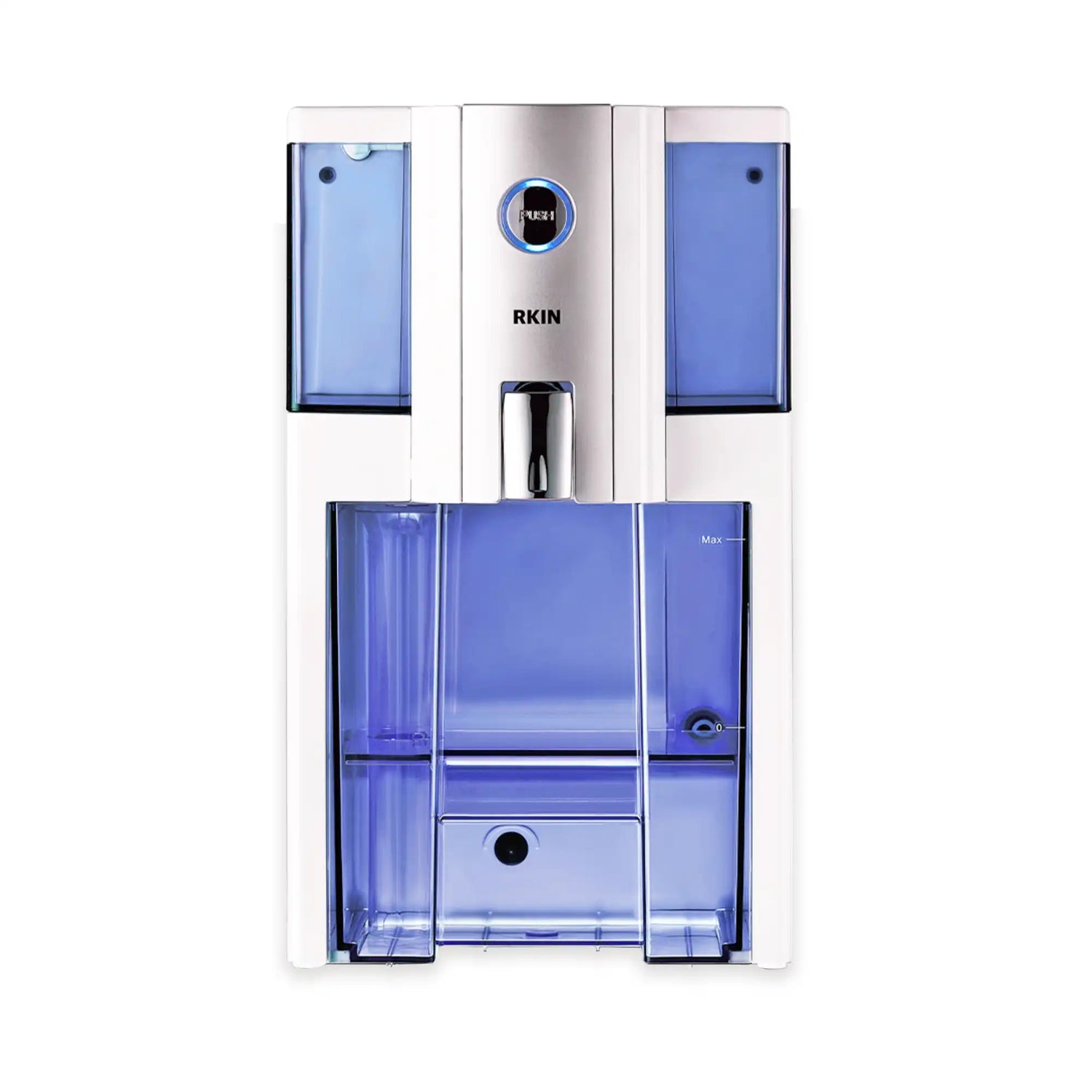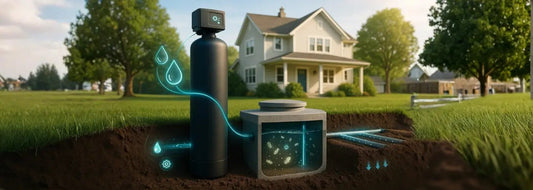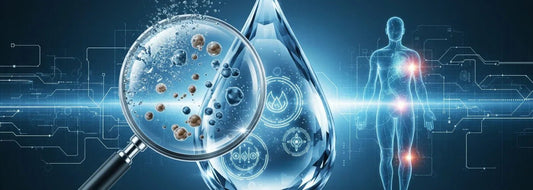
Water Softener vs Salt-Free Conditioner (2025 Guide)
Share
Battling Hard Water? Understanding Your Treatment Options
If you're a homeowner tired of dealing with the downsides of hard water, like spotty dishes, scale buildup in pipes and appliances, dry skin, and dull laundry, you've likely started researching water treatment systems. Two popular solutions often emerge: traditional water softeners and salt-free water conditioners.
But what's the real difference? And which one is the best fit for your home and lifestyle? This guide breaks down how each system works, its pros and cons, and helps you decide which path to take for better water quality in 2025.
Understanding these differences is key, whether you're a first-time buyer or looking to replace an old system.

First, What Exactly is Hard Water?
Hard water simply contains high concentrations of dissolved minerals, primarily calcium and magnesium. While generally safe to drink, these minerals cause various household headaches, most notably the formation of limescale or scale buildup. This affects:
- Plumbing and Appliances: Scale constricts pipes and coats heating elements in water heaters, dishwashers, and coffee makers, reducing efficiency and lifespan.
- Cleaning: Creates soap scum and makes it harder to get a good lather, leaving residue on surfaces, skin, and hair.
- Laundry & Dishes: Can leave clothes feeling stiff or dingy, and dishes spotty.
Traditional Water Softeners: Removing Hardness with Salt
Traditional water softeners tackle hard water head-on by removing the offending minerals.
How Salt-Based Softeners Work: The Ion Exchange Process
Conventional water softeners use a process called ion exchange. Inside the main tank is a bed of resin beads coated with sodium (or sometimes potassium) ions. As hard water flows through the tank, the calcium and magnesium ions (the "hardness" minerals that cause scale buildup) stick to the resin, and the sodium ions are released into the water in exchange. Essentially, the hard minerals are trapped and replaced.

Regeneration: Flushing the Trapped Minerals
Over time, the resin beads become saturated with hardness minerals and must be cleaned or "regenerated." This is where the salt comes in. A brine solution from a separate salt tank washes over the resin beads, flushing the trapped calcium and magnesium down a drain and recoating the beads with fresh sodium ions. Thus, this ion exchange capacity is restored.
Pros of Traditional Water Softeners
- Effectively Removes Hardness: Physically eliminates calcium and magnesium from the water.
- "Soft" Water Feel: Creates noticeably slicker-feeling water that lathers easily.
- Prevents Scale: By removing the minerals, scale buildup is effectively prevented.
- Reduces Soap Use: Less soap and detergent are needed for cleaning and laundry.
Cons of Traditional Water Softeners
- Requires Salt: You need to regularly buy and add heavy bags of salt.
- Uses Electricity: Needed for the electronic control valve and regeneration cycles.
- Needs a Drain: The regeneration process flushes salty wastewater (brine), requiring a drain connection.
- Adds Sodium: Small amounts of sodium are added to the treated water during ion exchange.
- Maintenance: Requires periodic checks and salt replenishment.

Salt-Free Water Conditioners: Neutralizing Hardness without Salt
Salt-free systems offer a different approach, focusing on preventing hard water problems without removing the minerals.
How Salt-Free Conditioners Work: TAC Technology
Salt-free systems don't actually remove hardness minerals. Instead, they condition the water using advanced media technology like Template Assisted Crystallization (TAC) or a similar Seed Assisted Crystallization (SAC) used in RKIN's Onlisoft system. As water passes through the specialized media inside the tank, the hardness minerals are transformed into microscopic, stable crystals. These harmless crystals remain suspended in the water but cannot easily stick to surfaces and form scale buildup.

Do Salt-Free Water Conditioners Work? Addressing Effectiveness
Yes, they work effectively at their intended purpose: preventing scale buildup. However, because they don't remove the minerals, they do not create the "soft" water feel associated with traditional softeners using ion exchange. If your primary goal is protecting your pipes and appliances from damaging scale buildup, a salt-free conditioner using TAC technology (or SAC) is a proven, low-maintenance solution.
Pros of Salt-Free Water Conditioners
- Prevents Scale: Effectively stops scale buildup formation in pipes and appliances.
- No Salt Required: Eliminates the need to buy or add salt.
- No Electricity or Drain Needed: Simpler installation and operation.
- Eco-Friendly: No wastewater or salt brine discharge.
- Very Low Maintenance: Often only requires periodic sediment pre-filter changes (media like RKIN's Onlisoft can last a lifetime).
- Retains Healthy Minerals: Calcium and magnesium remain in the water.
Cons of Salt-Free Water Conditioners
- Doesn't Remove Hardness Minerals: Water chemistry isn't fundamentally changed.
- No "Soft" Water Feel: Water won't feel slick, and lathering won't improve significantly.
- May Not Eliminate Spotting: Some spotting on surfaces like glass shower doors might still occur as water evaporates, leaving the harmless minerals behind.

Water Softener vs. Salt-Free Conditioner: Head-to-Head Comparison
Understanding the key operational differences is crucial. Let's use RKIN's systems as a specific example:
| Feature | RKIN Salt-Based Water Softener | RKIN Onlisoft Salt-Free Conditioner |
|---|---|---|
| Salt Replenishment Required | Yes | No |
| Drain Required | Yes | No |
| Electric Outlet Required | Yes | No |
| Metered Operation | Yes (for water/salt efficiency) | Not Applicable |
| Bluetooth & Mobile App | Yes | Not Applicable |
| Chemicals Added | No | No |
| Hardness Removed | Yes (via Ion Exchange) | No (Neutralized via SAC/TAC Technology) |
| "Soft" Feeling Water | Yes | No |
| Prevents Scale Buildup | Yes | Yes |
| Maintenance | Salt refills, potential checks | Sediment filter change (only) |
Key Differences Summarized
- Mechanism: Removal (Softener) vs. Neutralization/Conditioning (Salt-Free).
- Result: Soft-feeling water (Softener) vs. Scale prevention without soft feel (Salt-Free).
- Operating Needs: Salt, power, drain (Softener) vs. None (Salt-Free).
- Maintenance: Regular salt refills (Softener) vs. Minimal pre-filter change (Salt-Free).
- Environmental Impact: Wastewater discharge (Softener) vs. No waste (Salt-Free).
Which System is Right for You in 2025?
Choosing between a water softener and a salt-free water conditioner depends on your priorities:
Choose a Salt-Based Water Softener if...
- You strongly prefer the distinct "soft" feel of the water for showering and cleaning.
- You want the maximum reduction of soap scum and spotting.
- You don't mind the regular maintenance task of adding salt.
- You have easy access to electricity and a drain near the installation point.
- Local environmental regulations permit brine discharge from ion exchange systems.
Choose a Salt-Free Water Conditioner if...
- Your main goal is protecting plumbing and appliances from scale buildup.
- You prioritize an environmentally friendly option with no wasted water or salt discharge.
- You want a virtually maintenance-free system ("set it and forget it").
- You prefer not to add sodium to your water supply.
- You are okay without the traditional "soft" water feel.
Conclusion: Making the Informed Choice for Your Home
Both traditional water softeners and salt-free water conditioners effectively combat the negative effects of hard water, primarily scale buildup. The best choice comes down to understanding the fundamental difference: mineral removal via ion exchange versus mineral conditioning via TAC technology (or SAC).
Consider your primary goals – the desire for soft-feeling water versus eco-friendly, low-maintenance scale prevention – along with your tolerance for upkeep and any local regulations, to make the right decision for your home in 2025.
Frequently Asked Questions (FAQ)
Here are answers to some common questions about these systems:
Q1: How much do water softeners cost compared to salt-free conditioners?
A: Upfront costs are somewhat similar for both types based on size, brand, and features. Traditional softeners have ongoing salt expenses, usually around $7-$10 per 40-lb bag(April 2025 data). Salt-free conditioners have virtually zero running costs besides occasional pre-filter replacement.
Q2: Is softened water (from a salt-based system) safe to drink?
A: Yes, for most people. However, the ion exchange process does add a small amount of sodium to the water. Those on strict low-sodium diets should consult their doctor or consider using a reverse osmosis system for drinking water.
Q3: How difficult is the installation for each type of system?
A: Both typically require cutting into the main water line. Salt-based softeners also need a connection to a drain and a power outlet, making installation slightly more complex. Salt-free conditioners often just need inline plumbing, making them simpler. While some DIY is possible, professional installation is usually recommended for both if you are not mechanically inclined.
Q4: Will a salt-free conditioner remove other things like chlorine?
A: No. Both standard water softeners and salt-free conditioners primarily target hardness minerals (calcium and magnesium) to address scale buildup. They do not typically remove chlorine, sediment, heavy metals, or other contaminants. For those issues, you'd need a dedicated filter, like a carbon filter or a multi-stage whole-house filtration system.
Q5: Do I still need a whole-house filter if I have a softener or conditioner?
A: Often, yes. A sediment pre-filter is usually recommended before either system to protect it from dirt and debris. If you want to remove chlorine taste/odor or other contaminants, you'll need additional filtration stages, which can sometimes be combined with or installed alongside your softener/conditioner. Check out RKIN's water softener and carbon filter combo water systems.
Q6: How much maintenance does each system really need?
A: Salt-based softeners require you to periodically check and refill the salt tank (typically monthly or bi-monthly). Salt-free conditioners using quality TAC technology media (like RKIN Onlisoft) require virtually no maintenance on the main tank; only the sediment pre-filter needs changing (frequency depends on water quality and model, e.g., every 6-12 months).
Q7: Does RKIN offer installation services?
A: Installation service availability depends on your locality. It's best to check with the RKIN customer service to inquire about installation support or recommended installers in your area.
Ready to explore specific solutions? Learn more about RKIN's high-efficiency Salt-Based Water Softeners and innovative Onlisoft Salt-Free Water Conditioners to find the perfect fit for tackling your hard water problems. Contact us for a personalized consultation!




